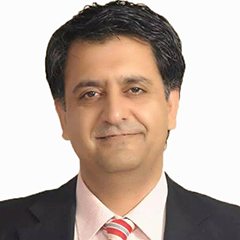
The Deobandi version of Islam in Pakistan is hardly what it started out to be in 1867 in India as a revivalist movement. The seven giants of the Islamic Jurisprudence of that time who established Dar-al Uloom Deoband included names like Rashid Ahmed Gangohi, Zulfiqar Ali, Shah Rafiuddin, Muhammad Yaqub and Muhammad Qasim Nanotvi. This religious seminary was once the second largest after Egypt’s Jamia Al-Azhar, and took on the tasks of spreading education, awareness and political reformation among the Muslims. This school, and school of thought gave birth to Jamiat-e-Ulmae Hind (JUH) in 1919.
In an effort to represent the Muslims, Deobandis adopted a role of peaceful political resistance against the British and viewed Hindus and Muslims as one nation under the common Indian identity. A few disagreed with this overarching identity of the Indian nation, and separated their ways to from Jamiat-e Ulmae Islam (JUI) in 1945. JUI viewed Muslims different from Hindus, and that made them a natural ally of the All India Muslim League in demand for Pakistan. JUI in Pakistan that is most famously led by Maulana Fazalur Rahman, Imran Khan’s ‘best friend!’
Not many know but Majlas-e-Ahrare Islam (MAI) was also born out of the JUH in 1929, and it professed a more conservative interpretation of Islam, but interestingly enough, mixed it with political ideas of socialism. MAI based itself on changing the society and adopted the truest possible colors of being a people’s movement. It had leaders like Syed Ataullah Shah Bokhari, Habibur Rahman Ludhianvi and Zafar Ali Khan. MAI is still running today with its Indian headquarter in Ludhiana, and Pakistani office in Lahore.
Although secular himself, the most famously known political scholar and leader of the Muslims, Ghulam Muhayyudin Ahmed (Maulana Abu al-Kalam Azad) had close relations with JUH. Although he was one of the leaders of the Khilafat Movement (1919-1922) that aimed at protecting the Ottoman Sultanate, he admired and drew inspiration from the role of Deobandi leaders during that time.
Religious influences mixed with successive political and social movements produced writers, speakers, poets and religious scholars who were connected with the masses. They were among the harbingers of the political process that liberated India, and within their own right provided political leadership to the masses. The Deobandi jigsaw had pieces of various colors that presented an interesting view to those who saw or dealt with them. But those days seem long gone now, as the sect is now almost synonymous with extremism and violence not only in South Asia but other parts of the world also, particularly Europe.
Religious influences mixed with successive political and social movements produced writers, speakers, poets and religious scholars who were connected with the masses
Sadly, a movement that aimed at reviving and reforming the religious and political thoughts among Muslims, itself badly needs revival and reformation of its religious and political inspirations. Reportedly fewer in numbers than the Brelvi Muslims, their political role and presence is much bigger particularly in India and Pakistan. They are much more organized, hardheaded and sharp bargainers whenever it comes to doing any sort of political or social business with them. This is especially true in Pakistan, where their influence on the State is overblown, but heavily effective. This is mainly because the Deobandis and the Pakistani State have been sharing the same strategic and political ideologies for over four decades. Both have used and misused each other depending on the challenge in a given time.
Under the doctrine of creating an (imaginary) Muslim Ummah, Pan-Islamism has always had a strong undercurrent of the Deobandi sect. Even prior to Partition, they were at the forefront providing support to movements in Afghanistan and Turkey. Given the mixture of Islam with local Sufi traditions, the Brelvis looked inward. But the ideals of Pan-Islamism motivated Deobandis to also look outward. The home-front was safe because of their connectivity with the State and a stronger experience of religious-political organization that came naturally to them. Since the creation of Pakistan, Brelvis and Shiites were partners with Deobandis during various religiously influenced movements in Pakistan but a major ‘boost’ to Deobandis came when the Soviet militarily entered Afghanistan and the Shiite-influenced Iranian revolution took place. Having hanged a popular political Prime Minister, Pakistan’s military ruler, General Ziaul Haq needed domestic and international legitimacy. The Soviet’s incursion in Afghanistan and the supposed desire of Iran to export the Shiite-revolution provided excellent opportunities to achieve that. Zia had strong Deobandi leanings. He had started favoring them from the beginning of his regime, and the time had arrived for Deobandis to start returning the favors.
Therefore, the rot began in Pakistan that sneaked into other parts of the world, and influenced the endless generations of Jihadists that many states had to grapple with.
The writer is a social entrepreneur and a student of Pakistan’s social and political challenges. Twitter: @mkw72
Published in Daily Times, September 5th 2017.
